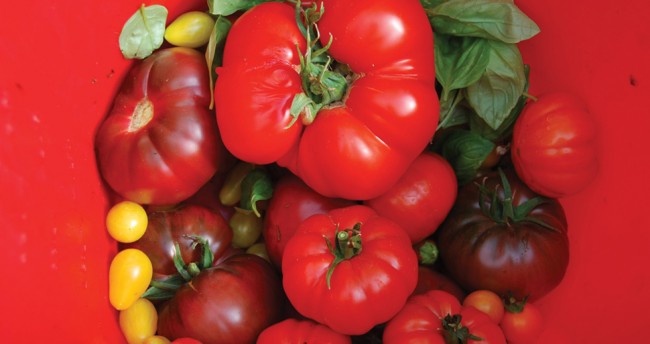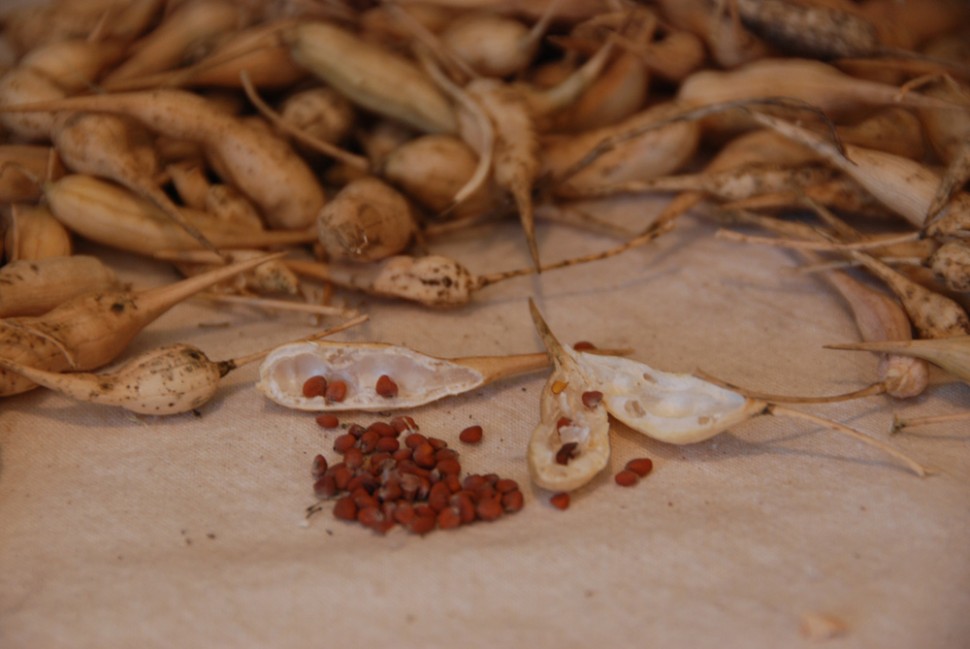
Photo Credit: Emily Bulmer
Seed-saving——a heritage tradition for the future
Before ordering seeds from a catalogue was common, seed-saving from the backyard and trading with neighbours was a tradition that generations of gardeners followed to keep harvests plentiful. Our grandparents’ reasons for saving seed were practical—seeds from a catalogue were expensive, and the generations steeped in war time and the Depression were socialized to save just about everything.
For our great-great-grandparents and their ancestors, commercial seeds were simply not available; seed-saving was the only way to maintain a garden. By saving seed from their best performing vegetables, gardeners and small-scale farmers developed varieties suited to their specific tastes and environmental conditions. As they traded their seeds with neighbours and nearby villages, genetic diversity increased from one year to the next, resulting in thousands of varieties of edible plants.
In 1866, a cabbage crop on Long Island, New York was the first commercial crop grown for seed in North America. Since then, home
seed-saving has been almost entirely replaced by the seed industry. As the worldwide industrial food system shifted into high production, seed companies concentrated on selecting for plants with high yield, uniform size and shape, and long lasting storage qualities. Over time, fewer and fewer gardeners and farmers saved seed, instead favouring commercial varieties from catalogues. While this shift seems like a natural evolution toward convenience, the practice has systematically decreased the diversity in the world’s food crops. It is estimated that over 90 percent of the fruit and vegetable varieties once available in North America are now extinct.
Genetic diversity is nature’s crop insurance system. When disease, pests, drought or wet weather overwhelm certain crops, a group of plants with genetic diversity will include individuals with unique, unseen characteristics that will help them survive. As the climate changes, as bee populations diminish, and plant diseases become more prevalent, it becomes increasingly important to have as much genetic diversity as possible to create a resilient food supply.
Caring about extinct heirloom varieties runs deeper than a sense of nostalgia; each variety is a specific, evolutionary solution to a series of unique growing condition challenges, and each loss makes our food system weaker.
Beginner to advanced techniques
Fortunately, saving seed from your garden is still possible. Beginner seed savers should start with beans, peas, lettuce, peppers and tomatoes. All of these plants are annuals, which means they produce seed in one season. They are also all self-pollinating, creating seed from one single flower, which reduces cross-pollination and results in offspring that look like the parent plant.
To save seed from any annual plant, allow the plant to mature beyond the eating stage. Lettuce will turn into a tall spike and radishes will get gigantic; both will start to flower. When the plant is brown and looks dead, collect the pods or seed heads that formed where the flowers were last seen.
Intermediate seed savers can try cucumber, radish, spinach, squash and pumpkin. These are annuals as well, but require separation from other plants of the same type to keep the seeds “true,” or looking like the parent. For example, two different species of squash or pumpkin can be planted next to each other, but two varieties of the same species will cross-pollinate. With cross-pollination comes more genetic diversity and the risk that the seeds would produce plants that look different from the parent—some of the characteristics you might like and some you might not. The results are unpredictable.
Top tips for all seed savers
Hybrids versus open-pollinated: Open-pollinated varieties are stable varieties resulting from the pollination between the same or genetically similar parents. Seeds from these plants produce new generations that are “true to type” (when not exposed to cross-pollination). F1 hybrids are the result of intentionally crossing two highly inbred lines of parent plants in a carefully controlled environment. Seeds of F1 hybrids are called F2 hybrids and often do not resemble the F1 plant. You can save seeds from F1 hybrids, just be prepared for inconsistent results.
Save the best: Resist picking the earliest fruit to eat—mark them for saving and let them mature instead. If you only save the seed that sets late in the year, you are inadvertently selecting plants for late, rather than early, ripening. If you see a plant that is producing many fruits, is especially tasty, or has a great colour, mark the plant with a ribbon and save some of the seed. Conversely, rip out plants that look sick, attract pests, mould or bear fruit that you don’t like.
Ripeness: Make sure the fruit or flower is fully mature before you harvest it for seeds, which is often far riper than what you would pick to eat. For example, to save seeds from a tomato, wait until it is slightly rotting on the vine. Allowing this extra time ensures the seed coats and embryos are fully formed.
Save the biggest seed: Plants from bigger seed tend to be more robust than plants grown from smaller seed. Selecting the largest seeds in crops such as peas and beans is easy to do just by looking at the cleaned seed. For small seeds such as tomato and tomatillo, blend the ripe fruit in a food processor with enough water to make a slurry. Once blended, put the mix into a bowl, add more water, stir, and allow the mixture to separate. Skim off and discard the pulp and seeds that float. The seeds that sink to the bottom are the best for saving; strain and dry them on a cookie sheet.
Clean and dry: Ensuring the seeds are dry and clean of chaff and other plant parts is important for successful storage. Any moisture present in the seeds will encourage mould growth, which will damage the seeds and reduce germination.
Label and store: To store seeds for one winter, a dry, cool room in containers such as paper envelopes, brown bags, glass canning jars, or plastic or metal containers works well. If your house is humid, dry the seeds well and store them in sealed containers. For longer periods, seeds can be stored in the freezer at -18ºC. When freezing seeds, it is even more important to ensure that they are dry, as any ice crystals that form inside the seed will destroy the embryo.
Seed saving can be complicated or simple, depending on your level of knowledge and personal goals. It is a satisfying activity that increases the knowledge of your own garden, creates your own crop insurance system, and contributes to long-term food security both locally and globally. Over time, you may even create a new plant variety!






